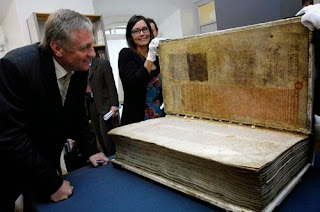The Codex Gigas, also known as the "Devil's Bible," is a medieval manuscript that is renowned for its remarkable size, intricate calligraphy, and its inclusion of a striking full-page illustration of the Devil. It is considered one of the most fascinating and mysterious texts from the Middle Ages. Here are some key details about the Codex Gigas:
Physical Characteristics:
- The Codex Gigas is an enormous manuscript, measuring approximately 36 inches (91 cm) in height, 20.5 inches (52 cm) in width, and about 8.7 inches (22 cm) in thickness. It weighs around 165 pounds (75 kilograms).
- The manuscript is made from vellum (calfskin) parchment, which was a common material for medieval manuscripts.
- Its large size and weight have led to its nickname, "Gigas," which means "giant" in Latin.
Content and Texts:
- The Codex Gigas contains a variety of texts, including the entire Latin Vulgate Bible, which includes the Old and New Testaments. It also contains other religious and historical texts, medical treatises, a calendar, and various practical instructions.
- Of particular interest is a section known as the "Ars Moriendi" or "The Art of Dying," which provides guidance on preparing for death and the afterlife.
The Devil's Illustration:
- One of the most iconic features of the Codex Gigas is its full-page illustration of the Devil, which appears on a single page near the beginning of the manuscript. The illustration depicts a large, imposing figure with horns, claws, and a fearsome expression.
- The Devil is surrounded by various symbols and intricate designs. His presence in the manuscript has contributed to the "Devil's Bible" moniker.
Legend and Lore:
- According to legend, the Codex Gigas was created by a monk who was condemned to be walled up alive as punishment for his sins. In order to avoid this fate, the monk supposedly promised to create a book containing all human knowledge in a single night.
- It is said that the monk invoked the Devil's assistance to complete this monumental task. The Devil's illustration is sometimes interpreted as a representation of this pact.
Historical Significance:
- The Codex Gigas is significant not only for its size and content but also for its historical and cultural value. It offers insights into medieval bookmaking, calligraphy, and the transmission of knowledge during that period.
- The manuscript is believed to have been created in the early 13th century, possibly by a single scribe, though additional researchers may have contributed to its creation.
The Codex Gigas is housed at the National Library of Sweden in Stockholm and is considered one of its most treasured possessions. While the legend surrounding its creation adds an air of mystery and intrigue, the manuscript itself is a testament to the craftsmanship and intellectual pursuits of the medieval era.



Comments
Post a Comment